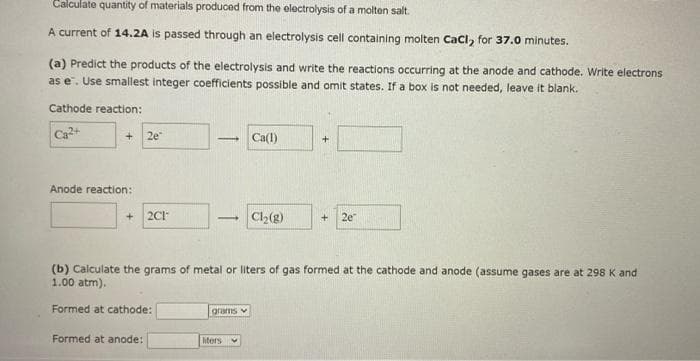A current of 14.2A is passed through an electrolysis cell containing molten CaCl₂ for 37.0 minutes. (a) Predict the products of the electrolysis and write the reactions occurring at the anode and cathode. Write electrons as e. Use smallest integer coefficients possible and omit states. If a box is not needed, leave it blank. Cathode reaction: Ca2+ + 2e Anode reaction: + 2C1 1 Ca(1) 1 Cl₂(g) + + 2e
A current of 14.2A is passed through an electrolysis cell containing molten CaCl₂ for 37.0 minutes. (a) Predict the products of the electrolysis and write the reactions occurring at the anode and cathode. Write electrons as e. Use smallest integer coefficients possible and omit states. If a box is not needed, leave it blank. Cathode reaction: Ca2+ + 2e Anode reaction: + 2C1 1 Ca(1) 1 Cl₂(g) + + 2e
Chemistry: Principles and Reactions
8th Edition
ISBN:9781305079373
Author:William L. Masterton, Cecile N. Hurley
Publisher:William L. Masterton, Cecile N. Hurley
Chapter17: Electrochemistry
Section: Chapter Questions
Problem 84QAP: Calcium metal can be obtained by the direct electrolysis of molten CaCl2, at a voltage of 3.2 V. (a)...
Related questions
Question
1

Transcribed Image Text:Calculate quantity of materials produced from the electrolysis of a molten salt.
A current of 14.2A is passed through an electrolysis cell containing molten CaCl, for 37.0 minutes.
(a) Predict the products of the electrolysis and write the reactions occurring at the anode and cathode. Write electrons
as e. Use smallest integer coefficients possible and omit states. If a box is not needed, leave it blank.
Cathode reaction:
Ca²+
Anode reaction:
+
2e
Formed at anode:
2C1-
- Ca(1)
1 Cl₂(g)
(b) Calculate the grams of metal or liters of gas formed at the cathode and anode (assume gases are at 298 K and
1.00 atm).
Formed at cathode:
grams
+ 2e
liters
Expert Solution
This question has been solved!
Explore an expertly crafted, step-by-step solution for a thorough understanding of key concepts.
Step by step
Solved in 3 steps

Knowledge Booster
Learn more about
Need a deep-dive on the concept behind this application? Look no further. Learn more about this topic, chemistry and related others by exploring similar questions and additional content below.Recommended textbooks for you

Chemistry: Principles and Reactions
Chemistry
ISBN:
9781305079373
Author:
William L. Masterton, Cecile N. Hurley
Publisher:
Cengage Learning

Chemistry & Chemical Reactivity
Chemistry
ISBN:
9781337399074
Author:
John C. Kotz, Paul M. Treichel, John Townsend, David Treichel
Publisher:
Cengage Learning

General Chemistry - Standalone book (MindTap Cour…
Chemistry
ISBN:
9781305580343
Author:
Steven D. Gammon, Ebbing, Darrell Ebbing, Steven D., Darrell; Gammon, Darrell Ebbing; Steven D. Gammon, Darrell D.; Gammon, Ebbing; Steven D. Gammon; Darrell
Publisher:
Cengage Learning

Chemistry: Principles and Reactions
Chemistry
ISBN:
9781305079373
Author:
William L. Masterton, Cecile N. Hurley
Publisher:
Cengage Learning

Chemistry & Chemical Reactivity
Chemistry
ISBN:
9781337399074
Author:
John C. Kotz, Paul M. Treichel, John Townsend, David Treichel
Publisher:
Cengage Learning

General Chemistry - Standalone book (MindTap Cour…
Chemistry
ISBN:
9781305580343
Author:
Steven D. Gammon, Ebbing, Darrell Ebbing, Steven D., Darrell; Gammon, Darrell Ebbing; Steven D. Gammon, Darrell D.; Gammon, Ebbing; Steven D. Gammon; Darrell
Publisher:
Cengage Learning

Chemistry by OpenStax (2015-05-04)
Chemistry
ISBN:
9781938168390
Author:
Klaus Theopold, Richard H Langley, Paul Flowers, William R. Robinson, Mark Blaser
Publisher:
OpenStax

Principles of Modern Chemistry
Chemistry
ISBN:
9781305079113
Author:
David W. Oxtoby, H. Pat Gillis, Laurie J. Butler
Publisher:
Cengage Learning
